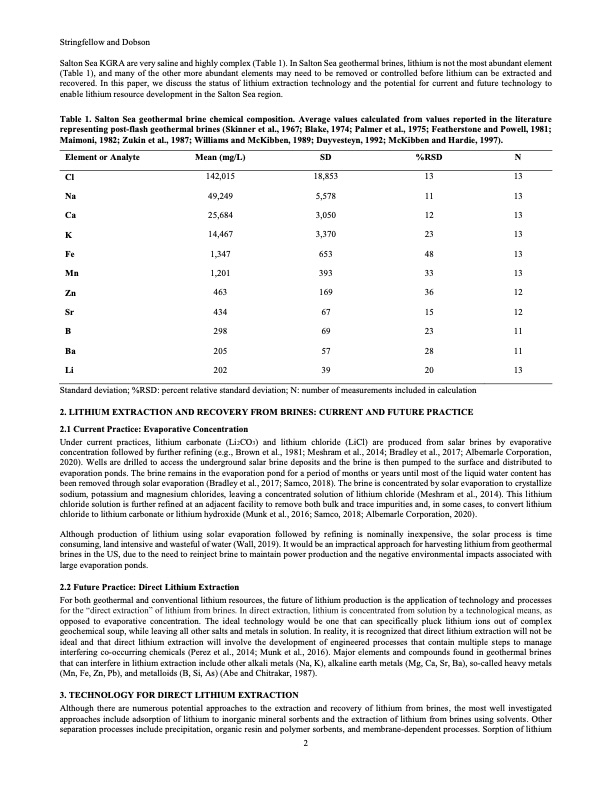
PDF Publication Title:
Text from PDF Page: 002
Stringfellow and Dobson Salton Sea KGRA are very saline and highly complex (Table 1). In Salton Sea geothermal brines, lithium is not the most abundant element (Table 1), and many of the other more abundant elements may need to be removed or controlled before lithium can be extracted and recovered. In this paper, we discuss the status of lithium extraction technology and the potential for current and future technology to enable lithium resource development in the Salton Sea region. Table 1. Salton Sea geothermal brine chemical composition. Average values calculated from values reported in the literature representing post-flash geothermal brines (Skinner et al., 1967; Blake, 1974; Palmer et al., 1975; Featherstone and Powell, 1981; Maimoni, 1982; Zukin et al., 1987; Williams and McKibben, 1989; Duyvesteyn, 1992; McKibben and Hardie, 1997). Element or Analyte Cl Na Ca K Fe Mn Zn Sr B Ba Li Mean (mg/L) 142,015 49,249 25,684 14,467 1,347 1,201 SD 18,853 5,578 3,050 3,370 653 393 %RSD N 13 13 11 13 12 13 23 13 48 13 33 13 36 12 15 12 23 11 28 11 20 13 463 169 434 67 298 69 205 57 202 39 Standard deviation; %RSD: percent relative standard deviation; N: number of measurements included in calculation 2. LITHIUM EXTRACTION AND RECOVERY FROM BRINES: CURRENT AND FUTURE PRACTICE 2.1 Current Practice: Evaporative Concentration Under current practices, lithium carbonate (Li2CO3) and lithium chloride (LiCl) are produced from salar brines by evaporative concentration followed by further refining (e.g., Brown et al., 1981; Meshram et al., 2014; Bradley et al., 2017; Albemarle Corporation, 2020). Wells are drilled to access the underground salar brine deposits and the brine is then pumped to the surface and distributed to evaporation ponds. The brine remains in the evaporation pond for a period of months or years until most of the liquid water content has been removed through solar evaporation (Bradley et al., 2017; Samco, 2018). The brine is concentrated by solar evaporation to crystallize sodium, potassium and magnesium chlorides, leaving a concentrated solution of lithium chloride (Meshram et al., 2014). This lithium chloride solution is further refined at an adjacent facility to remove both bulk and trace impurities and, in some cases, to convert lithium chloride to lithium carbonate or lithium hydroxide (Munk et al., 2016; Samco, 2018; Albemarle Corporation, 2020). Although production of lithium using solar evaporation followed by refining is nominally inexpensive, the solar process is time consuming, land intensive and wasteful of water (Wall, 2019). It would be an impractical approach for harvesting lithium from geothermal brines in the US, due to the need to reinject brine to maintain power production and the negative environmental impacts associated with large evaporation ponds. 2.2 Future Practice: Direct Lithium Extraction For both geothermal and conventional lithium resources, the future of lithium production is the application of technology and processes opposed to evaporative concentration. The ideal technology would be one that can specifically pluck lithium ions out of complex geochemical soup, while leaving all other salts and metals in solution. In reality, it is recognized that direct lithium extraction will not be ideal and that direct lithium extraction will involve the development of engineered processes that contain multiple steps to manage interfering co-occurring chemicals (Perez et al., 2014; Munk et al., 2016). Major elements and compounds found in geothermal brines that can interfere in lithium extraction include other alkali metals (Na, K), alkaline earth metals (Mg, Ca, Sr, Ba), so-called heavy metals (Mn, Fe, Zn, Pb), and metalloids (B, Si, As) (Abe and Chitrakar, 1987). 3. TECHNOLOGY FOR DIRECT LITHIUM EXTRACTION Although there are numerous potential approaches to the extraction and recovery of lithium from brines, the most well investigated approaches include adsorption of lithium to inorganic mineral sorbents and the extraction of lithium from brines using solvents. Other separation processes include precipitation, organic resin and polymer sorbents, and membrane-dependent processes. Sorption of lithium 2PDF Image | Lithium Extraction from Hybrid Geothermal Power

PDF Search Title:
Lithium Extraction from Hybrid Geothermal PowerOriginal File Name Searched:
2021-Stringfellow-Technology-for-Lithium-Extraction-in-the-Context-of-Hybrid-Geothermal-Power.pdfDIY PDF Search: Google It | Yahoo | Bing
Product and Development Focus for Infinity Turbine
ORC Waste Heat Turbine and ORC System Build Plans: All turbine plans are $10,000 each. This allows you to build a system and then consider licensing for production after you have completed and tested a unit.Redox Flow Battery Technology: With the advent of the new USA tax credits for producing and selling batteries ($35/kW) we are focussing on a simple flow battery using shipping containers as the modular electrolyte storage units with tax credits up to $140,000 per system. Our main focus is on the salt battery. This battery can be used for both thermal and electrical storage applications. We call it the Cogeneration Battery or Cogen Battery. One project is converting salt (brine) based water conditioners to simultaneously produce power. In addition, there are many opportunities to extract Lithium from brine (salt lakes, groundwater, and producer water).Salt water or brine are huge sources for lithium. Most of the worlds lithium is acquired from a brine source. It's even in seawater in a low concentration. Brine is also a byproduct of huge powerplants, which can now use that as an electrolyte and a huge flow battery (which allows storage at the source).We welcome any business and equipment inquiries, as well as licensing our turbines for manufacturing.| CONTACT TEL: 608-238-6001 Email: greg@infinityturbine.com | RSS | AMP |